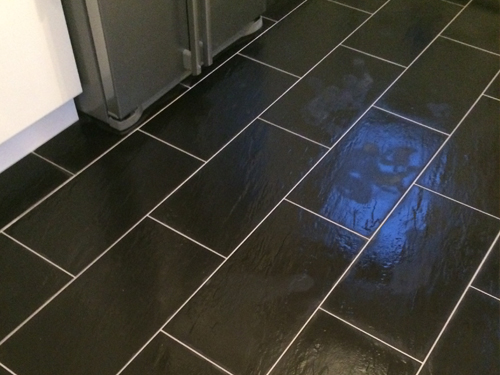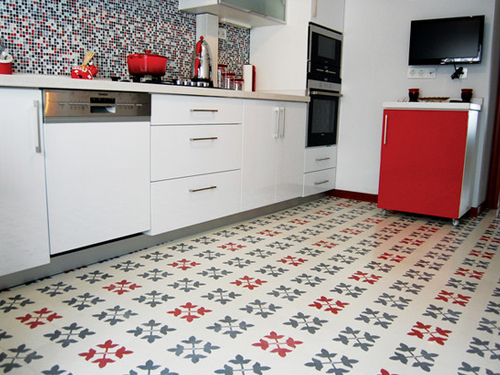
Ceramic
Ceramic tiles are made from a mixture of clay and other materials which is formed into the shape and size required and then fired in a kiln. The resulting 'biscuit' is then decorated and glazed to produce the finished tile. Hygenic and durable, ceramic tiles are widely available in an almost limitless range of colours, sizes, styles and finishes to suit all tastes.

Porcelain
Porcelain tiles are composed of fine porcelain clay and fired at a much higher temperature than traditional ceramic tiles making them much harder and more dense. Due its highly durable make-up, porcelain is more resistant to scratches and can withstand extremes of temperature. It is very stain resistant, has a very low water absorption rate and so can be used for interior and exterior applications. Porcelain tiles can be either glazed or unglazed. Unglazed porcelain tiles are usually polished to a high gloss shine but because they are not coated with a glaze, such tiles benefit from the application of a penetrating sealer to give it added stain resistance and to aid cleaning..

Terracotta
Terracotta is a ceramic material that has been used for construction and decorative arts since ancient times in cultures around the world. Terracotta, which literally means "baked earth", is made from natural clay which gives it a characteristic reddish-brown colour. Terracotta may be glazed for extra durability or to provide colour. Traditionally, terracotta tiles were sealed with boiled linseed oil and polished with beeswax although more advanced sealers and polishes are frequently used these days.

Quarry
Quarry tiles are made from certain types of clay which is extruded, kiln dried and then fired at extremely high temperatures. Frequently available in shades of red, brown and also black, they are the perfect solution for steps, halls, kitchens and any other high traffic area. They are normally frost proof, very durable and usually do not require sealing.

Travertine
Travertine is a sedimentary rock, a form of limestone composed of calcium carbonate. Formed from hot springs millions of years ago, the stone is characterised by pitted holes and troughs in its surface. A large quantity of it was used to construct The Colosseum in Rome and many other well-known buildings also feature it. Travertine can be purchased "filled" or "unfilled". It can be honed or polished to a smooth, shiny finish and comes in a variety of colours from white through to cream, beige and red. Like all natural stone, travertine should be sealed to give it added stain resistance and to aid cleaning. Being acid-sensitive, travertine should be cleaned with a neutral ph or slightly alkaline cleaner.

Marble
Marble is a metamorphic rock, a form of limestone composed mainly of calcium carbonate and found in many countries. It was formed under intense heat and pressure and features veins and swirls of colour. It can be supplied honed or polished to a very high finish and can be found in many colours. Like all natural stone, marble tiles should be sealed to give them added stain resistance and to aid cleaning. Being acid-sensitive, marble should be cleaned with a neutral ph or slightly alkaline cleaner.

Limestone
Limestone is a sedimentary rock formed over millions of years from deposits of marine invertebrates. It is predominantly cream or beige in colour with numerous fossilized remains in evidence. The Great Pyramid of Giza is constructed entirely of limestone and this is one of many examples of the use of limestone in construction from ancient times to the present day. It can be obtained honed or polished and like all natural stone, limestone should be sealed to give it added stain resistance and to aid cleaning. Being acid-sensitive, limestone should be cleaned with a neutral ph or slightly alkaline cleaner.

Granite
Granite is a widely occurring igneous rock in a wide variety of colours and mixtures from pink to grey and black. As it is very hard, water resistant and durable, granite is a popular material for floor tiles and also kitchen worktops. Granite surfaces are usually polished to a high shine although other finishes are available. Like all natural stone, granite tiles can be sealed to give it added stain resistance and to aid cleaning.

Slate
Slate is a fine-grained metamorphic stone found in many parts of the world. Traditionally found in shades of grey, it is also available in blue, purple, green and many other colours and mixtures. It is a very stable material and has been used for centuries as a roofing material. The stone is split into thin sheets from which the tiles are cut to size. As slate is a natural material, when split, each piece will be of varying thickness and hence the surface will not be uniformly flat. Like all natural stone, slate tiles should be sealed to give it added stain resistance and to aid cleaning. Slate looks particularly good when finished with a gloss or satin finish sealer.

Sandstone
Natural sandstone is a sedimentary rock composed mainly of quartz. It can be found in a variety of colours from sand to beige, red and grey. It has naturally good weathering properties and so is often used for exterior patios and paving. Due to its relatively coarse grain, sandstone tiles are most often supplied in a honed finish.

Mosaic
Mosaic tiles are small pieces of tile usually supplied on a mesh backing or sometimes paper faced. Originally they were used to create intricate designs or pictures. Examples of mosaics can still be seen at the ruined city of Pompei and fine examples of Roman mosaic floors are to be seen in the extensive collection at the Bardo Museum in Tunis. In addition to the example shown here, mosaics can be obtained in many shapes and sizes and also as feature borders in various designs. They can be made from all types of material including ceramic, glass and natural stone.

Encaustic
Encaustic tiles are a ceramic tile where the pattern is inlaid into the body of the tile. The patterns are made up of different colours of clay, heated into a liquid called the slip, poured into a mould and then fired. Encaustic tiles were first developed and used in the medieval period. It was in the gothic revival of the Victorian age that brought them back into popular demand and so they are often referred to as Victorian tiles. These tiles are usually laid to a pattern with similar tiles of different colours.


